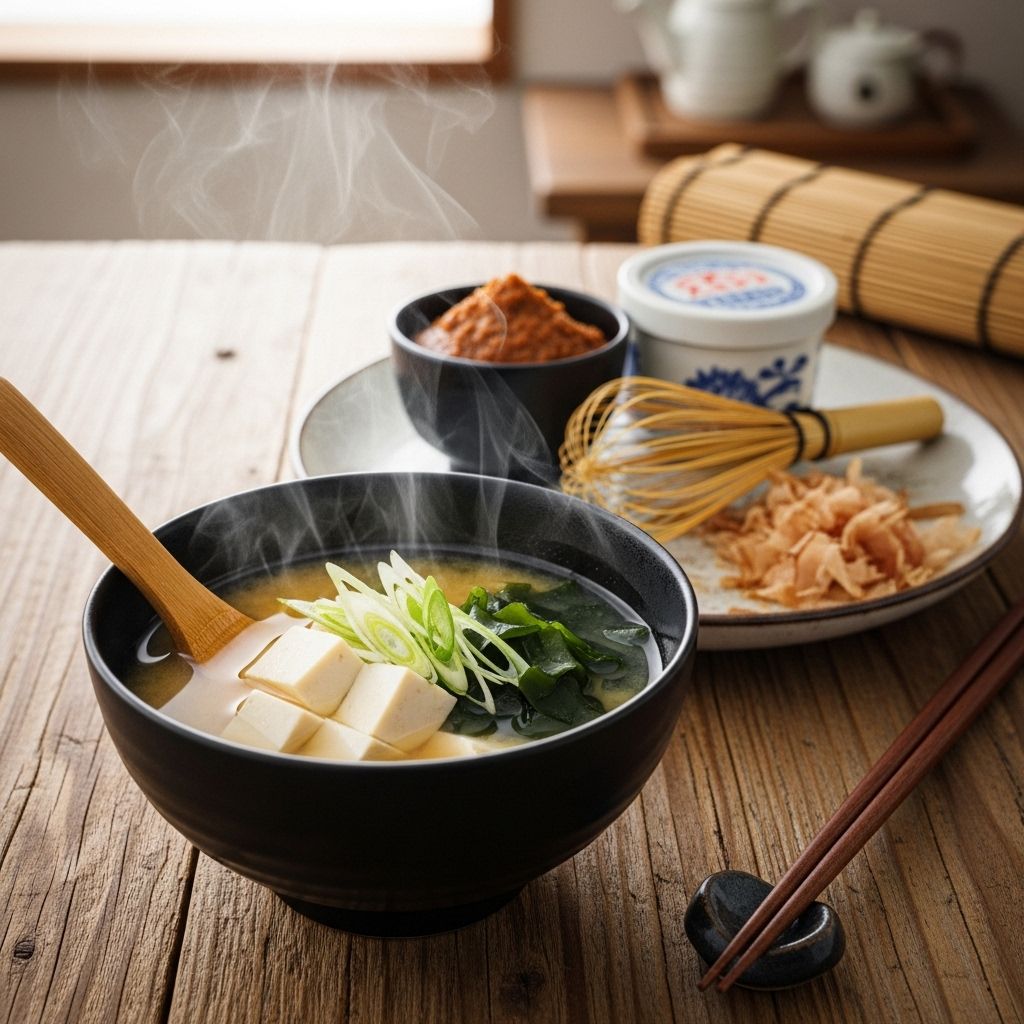How to Make Classic Japanese Miso Soup at Home
Craft a nourishing, umami-infused broth with pantry staples for a comforting starter.

Image: HearthJunction Design Team
How to Make Miso Soup
Miso soup is a staple of Japanese cuisine, renowned for its delicate umami flavor, nourishing properties, and simple ingredient list. Often served as an appetizer or side dish, it is also enjoyed any time of day for its comfort and versatility. This guide will show you how to prepare classic miso soup at home, including tips for ingredient selection, preparation steps, and delicious variations.
What Is Miso Soup?
Miso soup is a traditional Japanese soup consisting primarily of a dashi (broth) and miso paste. The soup frequently includes additions such as tofu, seaweed, and sliced green onions, making it highly adaptable to taste and seasonality. Its warming, umami-rich character makes it a favorite companion for Japanese meals and beyond.
Ingredients
- 4 cups water
- 2 teaspoons dashi granules (or homemade dashi stock)
- 3 tablespoons miso paste (white or red, according to taste)
- 1 (8 ounce) package silken tofu, diced into small cubes
- 2 green onions, sliced diagonally into 1/2-inch pieces
These ingredients reflect the classic miso soup found in Japanese households and restaurants, balancing savory dashi, earthy miso, and creamy tofu for a satisfying bowl.
Step-by-Step Directions
- Gather all ingredients.
- Prepare the Dashi: In a medium saucepan, combine the 4 cups of water and 2 teaspoons of dashi granules. Bring the mixture to a boil over medium-high heat.
- Add Miso Paste: Lower the heat to medium. Whisk in the miso paste, making sure to dissolve it thoroughly so no lumps remain. Avoid boiling the soup after adding miso, as high heat can destroy some of its beneficial enzymes and alter flavor.
- Incorporate Tofu: Gently stir in the diced silken tofu. Heat it through, but do not overcook, to maintain its delicate texture.
- Add Green Onions: Separate the layers of the sliced green onions and add them to the soup. Let the soup simmer gently for 2–3 minutes so the flavors meld, taking care not to let it boil.
- Serve Hot: Ladle the soup into bowls and enjoy immediately for the best flavor and texture.
Ingredient Notes and Variations
- Miso Paste: The most common types are white (shiro) and red (aka) miso. White miso is sweeter and milder, while red miso is more robust and salty. Adjust type and quantity according to your preference.
- Dashi: For authentic flavor, use dashi granules or prepare fresh dashi from kombu (kelp) and bonito flakes. Vegetarian options can use kombu dashi or mushroom broth.
- Tofu: Silken tofu is traditional, but soft or firm tofu can be substituted depending on the desired texture.
- Green Onions: Add a fresh, sharp flavor that balances the soup’s richness. Save some for garnish if desired.
- Add-Ins: Try adding wakame seaweed, mushrooms (such as shiitake), or other seasonal vegetables for variation.
Nutritional and Culinary Benefits
- Miso paste is rich in protein, vitamins, minerals, and probiotics that support digestive health.
- Tofu provides plant-based protein and a creamy texture without dairy.
- Dashi adds essential umami flavor, giving the soup its savory depth.
- Low in Calories: Miso soup is naturally light, making it ideal as a starter or healthy snack.
Expert Tips for Perfect Miso Soup
- Don’t boil the miso: Add miso paste after reducing the heat to preserve its flavor and nutrients.
- Use fresh ingredients: Fresh tofu, green onions, and proper dashi make a noticeable difference.
- Customize your soup: Make it your own with vegetables like mushrooms, spinach, or carrots.
- Serve immediately: Miso soup tastes best fresh and hot from the stove.
Classic Variations
- Authentic Miso Soup: For traditionalists, use dashi prepared from kombu and bonito flakes, add wakame seaweed, and top with green onion slices.
- Miso Soup with Mushrooms: Add shiitake mushrooms and a splash of soy sauce for earthy flavor.
- Vegetarian/Vegan Miso Soup: Skip bonito flakes in dashi, opting for kombu-only or vegetable broth, and include tofu, mushrooms, and greens.
- Seaweed Miso Soup: A handful of dried wakame or nori can be soaked and added for extra nutrition and authentic taste.
Serving Suggestions
- Appetizer: Serve miso soup as a warm starter with sushi, rice bowls, or grilled dishes.
- Side Dish: Pair with Japanese entrées such as teriyaki chicken, tempura, or gyoza.
- Light Meal: Add extra tofu, vegetables, or noodles for a nourishing, filling meal.
Frequently Asked Questions (FAQs)
Q: Can I make miso soup ahead of time?
A: Miso soup tastes best when served fresh, but you can prepare the dashi and vegetables ahead. Add miso paste just before serving to preserve its nutrients and flavor.
Q: What type of miso should I use?
A: White (shiro) miso is mild and sweet, ideal for delicate broths. Red (aka) miso is stronger and saltier, suitable for richer soups. Mix types or adjust amounts to taste.
Q: Can I make miso soup without dashi granules?
A: Yes. You can make dashi from scratch using kombu (dried kelp) and bonito flakes, or substitute vegetable broth for a vegetarian version.
Q: Is miso soup gluten-free?
A: Most miso paste is gluten-free, but some varieties contain barley or other grains. Always check packaging if you have dietary restrictions.
Q: Can I add other vegetables to miso soup?
A: Absolutely. Mushrooms, spinach, bok choy, daikon, and carrots are popular additions that provide seasonal flavor and nutrition.
Summary Table: Key Ingredients and Options
| Ingredient | Standard Option | Alternative/Substitution |
|---|---|---|
| Water | 4 cups | Vegetable broth |
| Dashi granules | 2 teaspoons | Kombu & bonito flakes, mushroom dashi |
| Miso paste | 3 tablespoons (white or red) | Mix of white/red, low-sodium miso |
| Tofu | 8 oz silken tofu, diced | Firm tofu, soft tofu |
| Green onions | 2, sliced | Leeks, chives |
| Additional vegetables | None (classic) | Wakame, mushrooms, spinach, carrots |
Reader Reviews and Pro Tips
“This miso soup is the real thing—the secret is the dashi granules. I had to go to a Japanese market to get it, but it was worth it!”
— Allrecipes Member Nancy
“We recently enjoyed a delicious miso soup at a sushi restaurant and were trying to come close to that. We actually thought this one was better! We’ll be making this often.”
— Allrecipes Member Diane S.
- Tip: For best results, dissolve miso paste in a little warm dashi before adding it to the soup to prevent clumping.
- Tip: Always add delicate herbs or greens just before serving to preserve their color and nutrients.
Conclusion
Homemade miso soup is an easy, deeply rewarding introduction to Japanese cooking. With just a handful of pantry ingredients and a few minutes, you can create a classic comfort food that’s endlessly adaptable and supremely satisfying. Experiment with add-ins and enjoy this healthy, warming soup any time of year.
References
Read full bio of Anjali Sayee












